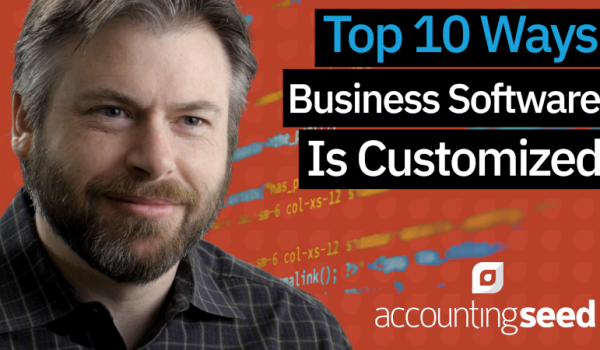
Author: Tony Zorc, CEO & Founder of Accounting Seed
The Root of the Article
Most software in the consumer market are very difficult, if not impossible to customize. However, business software for midsize and enterprise companies typically offer more in-depth customization. We’ll dive into why this is the case and reveal the top 10 ways business software is customized.
Whether businesses are using sales, service, operations, and accounting software, the situation often comes up where the users need the application to perform in a unique way. This is a common, natural occurrence. Companies grow more complex as they increase in size and market share. When this happens, customizing software helps meet new requirements. While it’s more common for larger-sized organizations to customize their own business apps, all companies can benefit from customization.
Customization Definition
Customization, when it comes to software, has become an overloaded term, grossly overused with a wide spectrum of definitions. Broadly defined, IT customization refers to an extension or modification of software to facilitate a specific outcome that wasn’t originally provided. There are 10 common types of customization that will let you do this to varying degrees. These customizations are also defined by the level of effort they take to implement.
Top 10 Ways Business Software is Customized
Let’s delve into the top 10 common types of customizations. We’ll explore:
-
- What is customization?
- What are the common uses for customization?
- How much technical skill is needed to create it?
- What costs are involved in initially writing and deploying it?
- AND What costs are involved in maintaining and updating the customization?
These customization categories are ranked from most common and simple to the least common and complex. You’ll also see the utility and limitations of each. Let’s begin.
1. Configuration Settings
Configuration settings are most commonly used to create:
-
- Default values
- Interface preferences
- Choices in how data is managed
- And communication around database events
This is a simple way to make your system’s view more suited to your needs and adapt it to your current processes and workflows. This is a great first step for making the system work with you, not against you. However, configuration settings are not considered a true customization. Therefore, the opportunity to control a business process with configuration settings is somewhat limited. Yet, one of the key benefits is that no technical skill is needed to manage configurations, only training for the user to set them up. There’s also no cost to implement them, other than the user’s time. And, there’s zero cost to maintain them!
2. Configured User Interface (UI)
A configured user interface (UI) is when the software maker allows you to organize and change the interface without any code. Simple UIs will have basic buttons or checkboxes to hide or show features on the screen. More elaborate applications allow you to drop and drag sections of data into the screen as well as related data tables.
The most advanced applications with configured UIs will often provide a library of components (or widgets) that can be pulled into the screen for utilities. Elaborate applications will also allow you to have a different UI configuration by user or security profile.
The big advantage of a configured UI is how it lets you streamline the entering and viewing data for each specific user. Just like configuration settings, no technical skill is needed to use and maintain this feature.
3. Custom Data Fields
Custom data fields allow users to track their own data on a standard table in the software. For example, you can add a text field to track a tax identification number on a customer record. Custom fields are very powerful as they allow you to track data that’s typically kept outside the system in emails and spreadsheets. Custom fields enable applications, and data reporting, to become well aligned with the underlying business process.
Typically, minimal technical expertise is needed to set up custom fields. Basic applications will require you to set up custom fields using programming languages, but these commands are typically simple. On the other hand, more sophisticated platforms will allow you to setup these fields with clicks and no code. Very little costs are incurred to set up custom data fields.
4. Custom Database Relationships
Custom database relationships are a special type of custom field that let you join multiple database tables together. They allow custom code to organize and access data more easily for entry. They also enable multiple data tables to be pulled together in one view for reporting purposes.
Custom database relationships are a powerful way to streamline data entry and are very useful for letting you build a specific way to report on your data. This feature makes your data more valuable and gives it more meaning to your organization. You can pinpoint and focus on the most relevant information to your business.
Similar to custom data fields, basic applications will require you to implement this feature using a programming language. Yet, more sophisticated platforms will allow you to set up these fields with clicks and no code. This is a very low-cost feature to establish and maintain.
5. Custom Data Tables
Custom data tables allow for an unlimited amount of data to be added to the application. While custom fields enhance the reporting and richness of the application in how it’s set up, custom data tables allow for a total tailored experience.
There is no limit to the custom data tables’ ability to add, combine, and relate your own proprietary data with that of the application. Again, generic, more basic applications require programming language knowledge to add custom tables. More sophisticated applications take the pain out of this process with clicks and no code.
The cost of creating custom data tables will vary significantly depending on how sophisticated the platform you’re using is. Once established though, custom data tables are typically easy to maintain and require little-to-no maintenance.
6. Custom Buttons and Links
Custom buttons and links are typically used to dictate navigation or launch custom coded routines. These features allow you to navigate the application in the exact way your natural business process works. In sophisticated applications, code can be executed with clicks of any custom button or link.
Custom buttons and links setup demands vary based on the sophistication of the technology platform you’re working with. Less sophisticated applications require programming to do this while more sophisticated, user-friendly platforms use clicks and not code.
7. Workflow Rules
Workflow rules are a tool to allow you to update or create a data record. You can also send a message or task based on an event in the database. Common uses of workflow rules include alerts, approvals, and simple status updates on records when they meet a user-defined criteria.
Typically, little technical skill is needed to create and maintain workflow rules. Often, all that is required is training and initial setup time.
8. User Interface (UI) Override
A user interface(UI) override is the ability to completely override a screen in the software application with your own custom page. This is the first true customization capability. Screen overrides allow a user a true entry and read-use of the data that aligns with their natural business process. They are a big step above a configured interface since they are built with a specific end-user in mind.
Quite a bit of technical skill will be needed for elaborate screens needed for UI overrides. A basic override may require at least some HTML knowledge. Implementing a complex override usually requires a programmer adept in multiple technologies and programming languages like CSS, JavaScript, and HTML.
The more complex the override, the more it will cost to write. Screen overrides also carry a cost of maintenance, as they need to be tested with new releases of the software. Some applications will require you to deactivate custom screens to get upgrades, forcing you to then test them and redeploy them with each new release.
9. Custom Triggers
Custom triggers are similar to workflow rules in that they create or update database records when an event takes place in the database. However, you can get very elaborate with the rules and conditions upon which data is created and or updated. Workflow rules only support very simple scenarios.
Custom triggers are very powerful in that they give you complete control over your process. Advanced programming skills are needed for custom triggers, so they aren’t easy to write. Therefore they can be expensive to create. They can also be costly to maintain as they often need to be tested with new releases of software.
10. Custom Scripts and Scheduled Jobs
Custom scripts are the most advanced and useful form of customization. A custom script is the ability to automate any number of tasks in an application. Elaborate applications will allow you to launch a custom script from a button somewhere in the application interface or just set it up as a scheduled job. A scheduled job is when the script will run automatically on a timer, usually daily, weekly, or monthly so no one has to remember to run the routine
Custom scripts require advanced knowledge of programming and database design. They aren’t easy to write, and maintenance can actually be more costly than the initial write of the code. Again, this customization needs to be tested and potentially updated with each new version of the core software.
Customization Brings Ease and Innovation for Your Business
A few software platforms like Accounting Seed offer all 10 of these customizations. All of them are useful in how they make the technology fit your needs and make things easier. Customization empowers your organization by giving you the functionality you need to streamline processes the ways that best work for you. For accounting, this helps you save time and money while allowing you to fully harness financial data as a tool to improve your business.
See Accounting Seed in action
Get a close-up view of how accounting on Salesforce can eliminate the need for costly integrations—and silos of mismatched information—by sharing the same database as your CRM.



